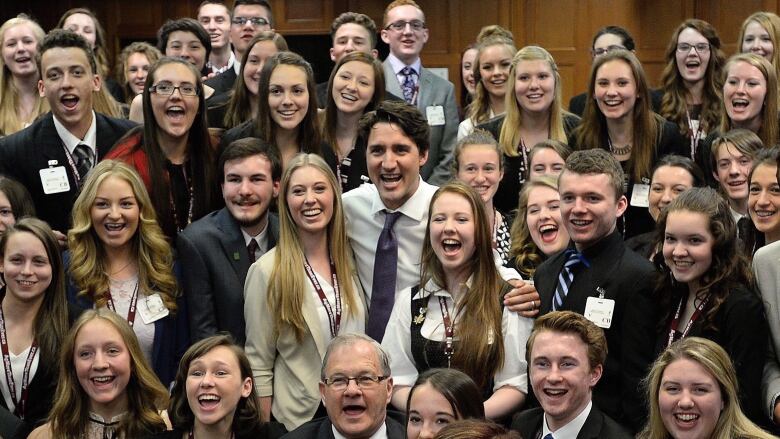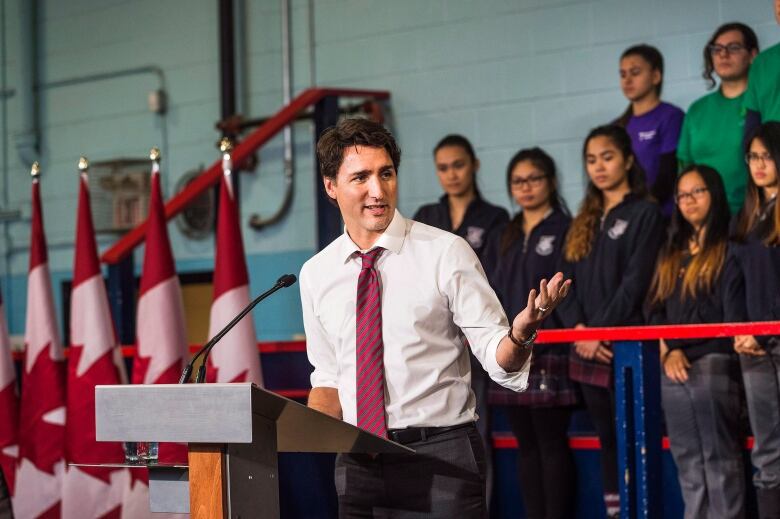Trudeau doubles Canada Summer Jobs spending, but student employment stays flat
'There's a real danger in artificially creating jobs,' youth employment chair says

Last spring, the Liberal government doubled the amount of money available to subsidize student wages under the Canada Summer Jobs program.
But despite theboost,Statistics Canada foundstudent summer employment rates for 2016 stuck roughly wherethey were in 2015.
What happened?
In February, Prime Minister Justin Trudeau who serves as his government's minister of youthmarked the end of his first 100 days in office by announcing an extra$113 million ayear for the next three years for the Canada Summer Jobs program,doublingits annual budget of $107.5million.
In June, Trudeauwas out touting the results.
Thanks to an "unprecedented response from employers" (30 per cent more applications, from small businesses in particular), the money was backstopping77,000 jobs 7,000 more than originally expected.
The 2015funding subsidized34,179 jobs.
Employment and Social Development Canada says it won't report itsfinal2016 numbers until December.
Rosy press releases
The jobnumbers quoted by Trudeauand in a series of "best summer ever"announcements fromregional ministers and Liberal MPs through late July weren't official.
But press releases touting a "record number of jobs and opportunities" created by the programsaid doubling spending paid off across Canada:from 19 per cent more jobs in Newfoundland and Labrador to 231 per cent more jobs inthe three territories combined.
- 1,873 summer jobs to be created in Sask.
- More than 500 new summer jobs for NL students
- P.E.I. employers hire more students under federal program
Alberta and B.C.'s Canada Summer Jobsannouncements touted135 and 133 per cent more jobs, respectively, while Ontario had a 159 per cent increase.
Rosy releases aside,did the new jobs subsidized by the program actually boost the country's overallstudent employment rate?
In short: No.
'Artificial' jobs?
The Statistics Canada labour force survey released early last month found that for students aged 15-24 returning to full-time studies this fall,the average summer employment rate (May to August) was48.8 per cent, down slightly from49.1 per centin2015.
The average unemployment rate for students aged 20-24 was 10.2 per cent, virtually unchanged from the 10.1 per cent observed in 2015. For those aged 17-19, it declined to 15.3 per cent from 17.3 per cent in 2015, and for 15-16-year-olds, it was 28.1 per cent, compared with 29.7 per cent the previous summer.

Would things have been worse for students without this spending?
While one canspeculate, that kind of counter-factualargument is very difficult to prove, saysMorleyGunderson, theCIBCchair of youth employmentat the University of Toronto.
He says a"stable, growing economy is the best tonic" for student employment.
When the economy is struggling, student jobs are often the first to go. They can also bethe last to benefit from a recovery.
"There's a real danger in artificially creating jobs," he said. "That's generally not sustainable ...We need employers making their own hiring decisions."
And then there arethe possible trade-offs with atargeted program like Canada Summer Jobs.
"Are studentstaking the job of someone else who could do the work?" he said.
Riding budgets didn't simplydouble
Recentlytabled responses to questions put on the House of Commons order paper by both Conservative and New Democrat MPs reveal how $107.4 million in new money was allocated across Canada. (Employment and Social Development Canada says the difference between this and the $113 million announcedis the cost of administration.)
The government didn't justdouble the budget for each riding.
The new money was divvied up basedonstudent unemployment data from Statistics Canada and riding-specificdata from the 2011 census. (Employment information that year was collected in the voluntary survey that replaced the long-form census.)

For example,in 2015, four ridings had over $1 million budgeted all of them in Newfoundland and Labrador. Many Atlantic Canadian ridings had large budgets, in linewith the region's employment challenges.
With the new funding formula, 13 ridings had million-dollar budgets in 2016: four in Newfoundland and Labrador, but also otherplaceslikely to havemany students looking for worklike Halifax, Montreal and London, Ont.
'Tiny drop in the bucket'
University of Ottawa labour economist David Gray says theeffectiveness of the program is about more than the unemployment rate.
Thisspending is a "tiny drop in the bucket" of the total Canadian economy, he said. What may count more is themeaningful training or skills experience students gain.
While economists debate whether it's agovernment's role to create jobs, "there's no doubt that 77,000 young people benefited," he said.
The program isa targeted wage subsidy for selected employers. It alsopads the bottom line ofsmall businessesat a time when this government may have neededan olive branch to extend.
"Politics always matters," Gray said.
- TrudeauTracker: Has PMdelivered on promises for youth?
- PM marks 100 days with boost to summer jobs program
How theCanada Summer Jobs program works:
Public sector, not-for-profit organizations and small businesses with 50 or fewer employees can apply for wage subsidies to hire full-time students aged15-30.
For-profit businesses and public sector employers can receive funding worthup to half of their province or territory's minimum wage for full-time work lasting between sixand 16 weeks. Not-for-profit organizations can apply for 100 per cent of theminimum wage. (Employers canoffer higher salaries, at their own expense.)
Employers must attest that they could not create the job without help. Apoints systemevaluatesapplications based on federal government priorities, such as:
- Syrian refugee resettlement projects, includinghiring Syrian students.
- Hiring Indigenous students.
- Cultural and creative industries, including projects for Canada's150thanniversary in 2017.
- Small business innovation and expansion.












_(720p).jpg)


 OFFICIAL HD MUSIC VIDEO.jpg)
.jpg)



























































































